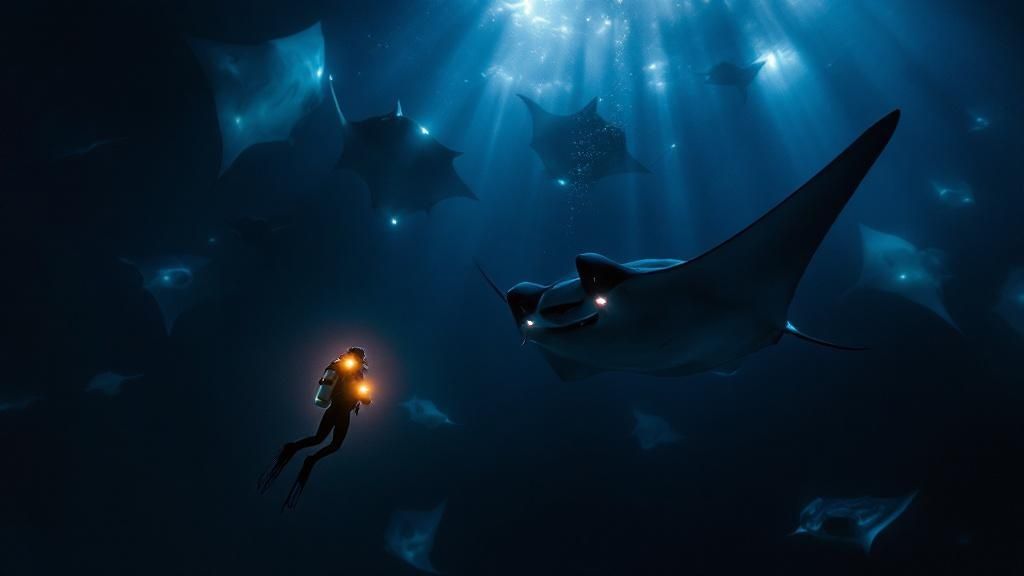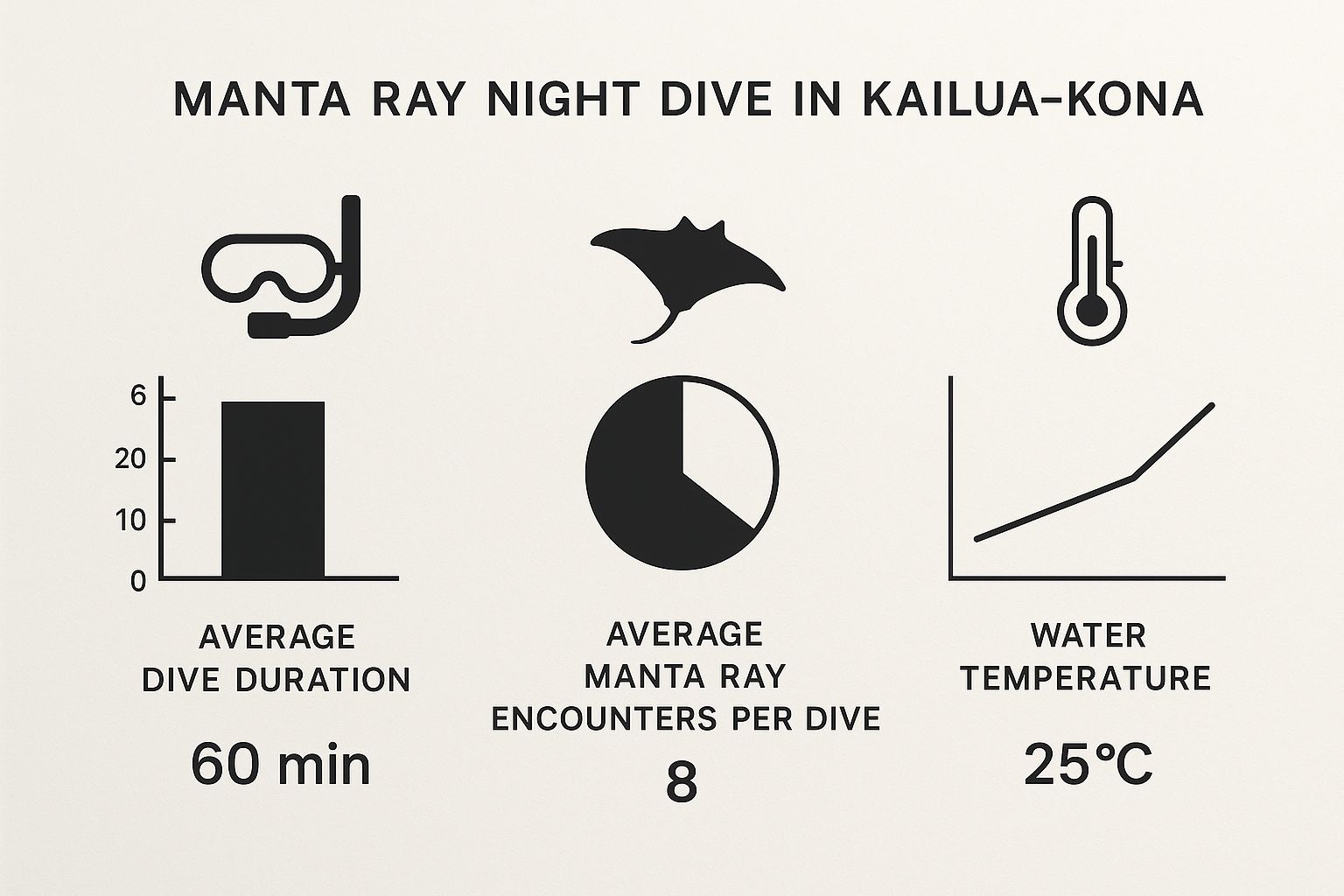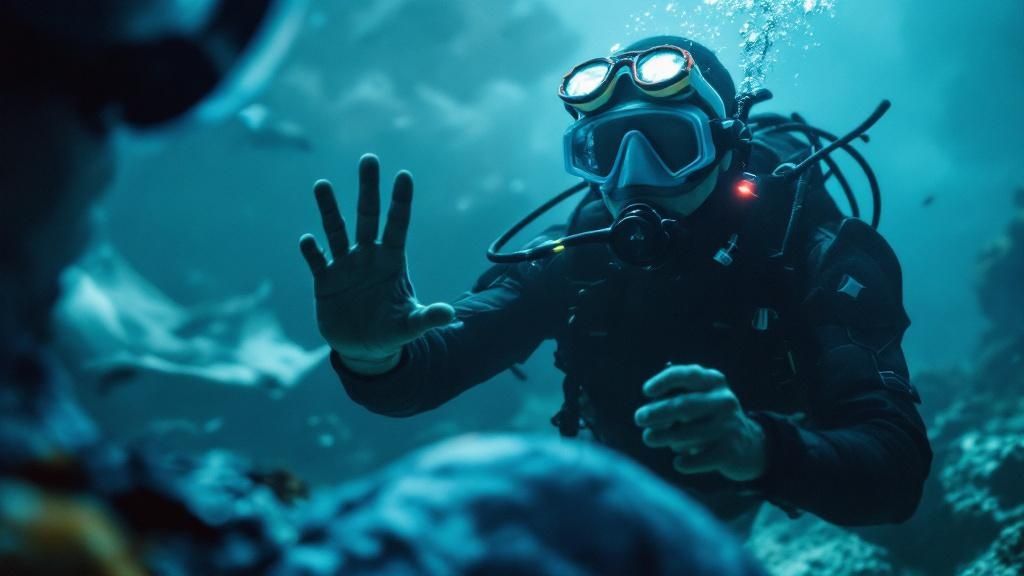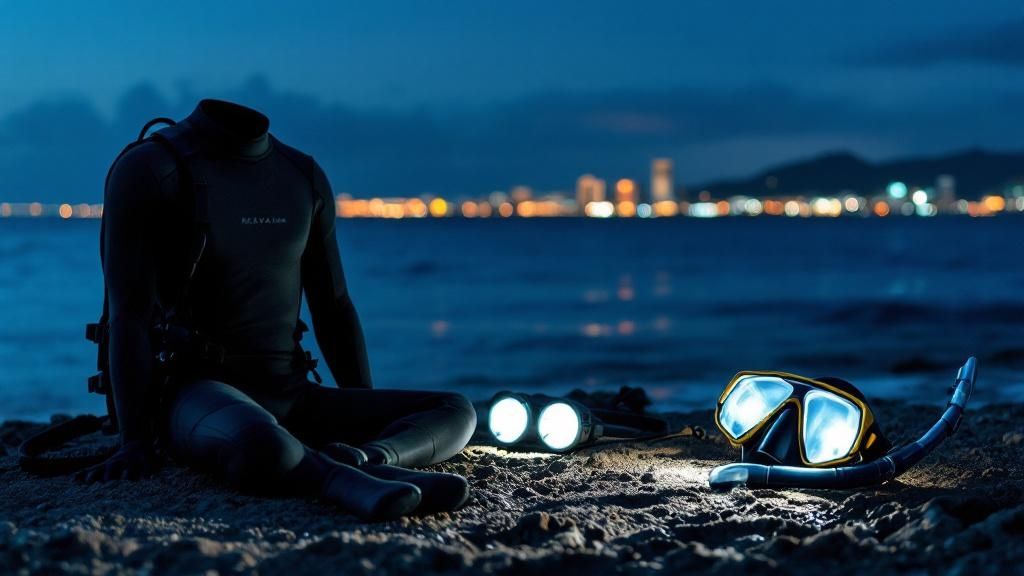Why Kona Reigns As The Ultimate Manta Ray Destination
Kailua Kona isn't just another pretty Hawaiian town; it's the global hotspot for manta ray encounters. What sets this location apart? It's the unique blend of geological and ecological elements that create a haven for these gentle giants. Nutrient-rich volcanic waters surrounding Kona are a breeding ground for plankton, the manta ray's main food source. These waters, along with protected coastal areas, allow these magnificent creatures to flourish.
This means Kona offers year-round manta ray sightings, a consistency unmatched by other destinations. Most other locations experience seasonal migrations, making sightings unpredictable. Kona's resident manta ray population, however, ensures reliable encounters throughout the year. For instance, the Kona Coast of the Big Island is globally renowned for its exceptional manta ray night dives, attracting approximately 80,000 participants annually. These dives typically have a high success rate, between 80% and 90%, making Kona one of the most reliable places in the world to see manta rays. Find more detailed statistics here.

The Volcanic Advantage
The volcanic coastline is key to this manta ray paradise. The underwater topography, sculpted by ancient lava flows, creates channels and slopes that funnel plankton towards the surface. This natural concentration of food attracts mantas, making specific locations predictable feeding grounds. The volcanic rock also provides shelter and cleaning stations, contributing to the mantas’ overall health. Before your trip, check out resources like Allstays RV.
Ocean Currents: The Plankton Highway
Specific ocean currents further enrich Kona's plankton-rich environment. These currents carry vital nutrients from deeper waters to the surface, boosting plankton growth and creating a steady food supply for the mantas. Think of them as plankton highways, delivering a continuous stream of nourishment. This reliable food source, coupled with the volcanic landscape, establishes Kona as a true bucket-list destination, delivering unforgettable manta ray encounters. You might be interested in learning How to master…. Whether you're an experienced diver or a first-time snorkeler, a manta ray night dive in Kailua Kona is an exceptional opportunity to witness these creatures in their natural environment.
Manta Heaven Vs Manta Village: Finding Your Perfect Match
Choosing between Kona's two famous manta ray night dive sites can be tough. Manta Heaven (Garden Eel Cove) and Manta Village both offer incredible experiences, but each has its own distinct charm. This guide will break down the key characteristics of each site, helping you decide which one best suits your diving style and expectations.
Manta Heaven (Garden Eel Cove): The Lively Hub
Manta Heaven, also known as Garden Eel Cove, is located north of Kona, near the airport. It's renowned for attracting large groups of manta rays. While the sighting success rate is around 90%, slightly lower than Manta Village, the average number of mantas seen per dive is considerably higher. This makes Manta Heaven an exciting option for divers hoping to witness a dynamic feeding frenzy with numerous mantas interacting. This popularity, however, often means more divers in the water.
Manta Village: The Intimate Encounter
South of Kona in Keauhou Bay lies Manta Village, offering a different kind of experience. With a sighting success rate exceeding 96%, this site is generally less crowded, providing a more intimate encounter with these gentle giants. You might see fewer mantas overall compared to Manta Heaven, but the calmer waters and higher sighting likelihood make it ideal for beginners or those preferring a more relaxed dive. The shorter boat ride to Manta Village is another advantage, especially for those prone to seasickness.

This infographic illustrates key metrics for manta ray night dives in Kailua Kona, including average dive duration, typical number of manta rays encountered, and average water temperature. The water temperature consistently hovers around a comfortable 25°C, and dives typically last an hour. The potential for seeing multiple manta rays per dive is what truly sets these experiences apart. For a deeper dive into the manta ray experience, check out this article: What It's Like to Go on a Manta Ray Dive in Kona.
To further compare the two sites, take a look at the table below:
To help you visualize the key differences and similarities between Manta Heaven and Manta Village, we've compiled the following comparison table:
Manta Heaven vs Manta Village Comparison:
Detailed comparison of the two main manta ray dive sites including success rates, average manta sightings, and key characteristics.
| Feature | Manta Heaven (Garden Eel Cove) | Manta Village |
|---|---|---|
| Location | North of Kona (near airport) | South of Kona (Keauhou Bay) |
| Sighting Success Rate | ~90% | >96% |
| Average Manta Rays Encountered | Higher (potential for large groups) | Lower (more intimate encounters) |
| Crowd Levels | Typically more crowded | Generally less crowded |
| Water Conditions | Can be more dynamic | Calmer waters |
| Boat Ride | Longer | Shorter |
| Experience Level | Suitable for all levels, but exciting for experienced divers seeking large groups | Excellent for beginners and those seeking a relaxed dive |
This table summarizes the key features of both sites, highlighting the trade-offs between a potentially larger manta ray spectacle at Manta Heaven and a calmer, more intimate experience at Manta Village.
Choosing Your Perfect Spot
The "best" spot truly depends on what you're looking for. Do you want to maximize your chances of seeing a large number of mantas, even in a more crowded environment? Or do you prefer a quieter, more guaranteed sighting in a relaxed setting? Consider these factors, your experience level, and your comfort in the water to choose the perfect manta ray night dive experience in Kailua Kona.
Decoding Manta Ray Behavior And The Feeding Spectacle
Understanding the behavior of these magnificent creatures elevates a manta ray night dive in Kailua Kona from simply amazing to truly magical. Their impressive wingspans, reaching up to 12 feet, and specialized cephalic fins create a captivating underwater ballet as they filter plankton.
The Underwater Ballet: How Mantas Feed
Manta rays are filter feeders, consuming massive quantities of microscopic plankton. They use their cephalic fins, located on either side of their mouths, to funnel plankton-rich water into their mouths.
As they gracefully glide through the water, they often perform acrobatic maneuvers like barrel rolls and loops, maximizing their plankton intake. This feeding process isn't just efficient; it's a mesmerizing spectacle to behold.
The Kona Coast Connection: Research and Insights
The reliability of manta ray encounters in Kona is deeply rooted in their predictable behavior. From 2009 to 2014, longitudinal studies and video documentation along the Kona Coast, focusing on sites like Manta Village and Manta Heaven, yielded crucial insights into manta ray behavior, abundance, and movement patterns.
Researchers meticulously tracked individual manta rays, analyzing their physical conditions and mapping their locations to understand these gentle giants. Discover more insights about manta ray statistics. This research helped establish the area as a prime location for manta ray night dives.

The Allure of Light: Why Night Dives Work
Dive lights play a crucial role in attracting mantas to the surface during night dives. The lights attract plankton, creating a concentrated food source that draws the mantas in.
This allows divers to witness the spectacular feeding frenzy up close. This predictable response to light demonstrates the mantas' intelligence and adaptability. Understanding these behavioral patterns enriches the dive experience and contributes to ongoing conservation efforts.
By learning how these gentle giants interact with their environment, we can better protect them and their habitat. This knowledge transforms a simple dive into a meaningful contribution to marine conservation.
Site Fidelity and Movement Patterns
Manta rays exhibit strong site fidelity, meaning they return to the same feeding grounds regularly. This predictable behavior is a key reason why manta ray night dives in Kailua Kona are so reliable.
Additionally, research has revealed specific movement patterns and migratory routes, furthering our understanding of how these creatures navigate their environment. This knowledge allows dive operators to pinpoint the best locations for viewing, ensuring a high likelihood of magical encounters. The more we learn about manta rays, the better equipped we are to preserve their presence in Kona's waters.
Your Complete Manta Ray Night Adventure Experience
Picture this: a vibrant Kona sunset paints the Hawaiian sky as your boat leaves the harbor. Anticipation hangs in the air, growing with every passing moment. As you approach the dive site, the excitement becomes almost tangible. Then, the magic unfolds. Manta rays, graceful and ethereal, begin their mesmerizing feeding dance beneath the lights, a scene straight out of a dream.
Preparing for Your Adventure: From Briefing to Water Entry
Your manta ray night dive adventure in Kailua Kona starts with a thorough briefing. Experienced guides will cover the equipment, safety protocols, and the overall flow of the experience. You'll learn how to use your snorkel gear and find the best position in the water for optimal viewing. This preparation helps you feel comfortable and confident before you even enter the water for this incredible encounter.
Guides will also explain the importance of respecting these gentle giants. This means keeping a safe distance and never touching the mantas, as this can harm their delicate mucous layer. They’ll also emphasize the importance of turning off your flash, which can disorient and stress the animals. The briefing not only prepares you for the dive but also promotes responsible interaction with these amazing creatures.
Maximizing Your Viewing Experience: Insider Tips and Techniques
Once in the water, the real adventure begins. Guides will lead you to the prime viewing area, often using anchored lights to attract plankton, the manta rays' primary food source. This creates a central feeding spot for the mantas, improving your chances of up-close encounters. Learn more in our article about What a Manta Ray Night Dive Is.
For the best views, position yourself horizontally in the water, floating on the surface if you're snorkeling, or kneeling on the ocean floor if you're diving. This lets you see the mantas from below as they glide and swoop overhead. Avoid sudden movements or splashing, which can frighten the mantas. Instead, maintain a calm and respectful presence, allowing these gentle giants to approach you naturally.
Manta Encounters Up Close: What to Expect and How to React
When the mantas approach, it's crucial to stay calm and avoid sudden movements. These creatures are naturally curious and gentle, and they may come surprisingly close. You might even find yourself face-to-face with a manta ray, a truly awe-inspiring experience. Remember to follow your guide’s instructions, keeping a respectful distance while soaking in the magic of the moment.
Capturing this unforgettable experience is essential. Remember to turn off your flash, as it can disturb the mantas. If using a GoPro or other underwater camera, adjust the settings for low-light conditions beforehand. This will help you capture beautiful images without impacting the mantas’ behavior. Patience is key. Manta rays are graceful but their movements can be unpredictable. By observing their patterns, you'll be able to capture truly memorable photos and videos.
Addressing Common Concerns: Seasickness and First-Time Jitters
Many people diving with manta rays for the first time have concerns about seasickness or anxiety about swimming at night. Rest assured, there are ways to manage these concerns. If you’re prone to seasickness, consider taking medication beforehand, opting for a larger, more stable boat, or focusing on the horizon during the boat ride.
If you're nervous about the water, talk to your guide. They can provide reassurance and support, helping you feel comfortable and confident. Focusing on your breathing can also help manage anxiety, both in and out of the water. By addressing these common worries, you can fully embrace the wonder of this unique marine adventure.
Timing Your Adventure For Maximum Manta Magic
Timing is everything when it comes to experiencing the magic of a manta ray night dive in Kailua Kona. The difference between a good dive and an unforgettable one often hinges on understanding the interplay of several natural factors. These include moon phases, weather conditions, and the presence of plankton blooms, all of which affect manta ray activity.
The Influence of Nature: Moon, Weather, and Plankton
The moon plays a significant role in the visibility of plankton, a manta ray's primary food source. Less moonlight makes the plankton more visible, drawing the manta rays closer to the surface where the dive lights concentrate these tiny organisms. This creates an incredible feeding spectacle for divers and snorkelers alike. Additionally, calmer seas and increased visibility during specific times of the year contribute to a more comfortable and enjoyable dive. Experienced guides, armed with local knowledge, use these subtle clues to predict exceptional viewing nights.
Weather patterns also influence manta ray behavior and, in turn, your dive experience. Ocean visibility is paramount for observing these gentle giants, and is directly impacted by wind, rain, and currents. For example, during the winter months (November-March), increased winds and rougher seas can occasionally lead to tour cancellations. However, local operators often adapt by choosing sheltered dive sites or adjusting dive times, even in less-than-ideal conditions.
Furthermore, plankton blooms directly impact manta ray activity. These blooms, affected by water temperature and nutrient levels, provide a feast for the manta rays, increasing the likelihood of witnessing spectacular feeding frenzies. For an extra energy boost before your dive, consider exploring some natural energy boosters.

Planning for Success: Booking Strategies and Backup Plans
Strategically planning your manta ray night dive involves understanding the natural factors at play and developing practical booking strategies and backup plans. Booking in advance, particularly during the peak season (June-August), is strongly recommended due to high demand. For a more detailed guide on planning your trip, check out our resource on the best time to visit Kona for manta rays.
While manta rays grace Kona's waters year-round, the late spring, summer, and early fall (April-October) typically offer the most favorable conditions. This period often boasts calmer waters and increased visibility. However, if your trip falls during the winter months, it's wise to be prepared for potential rescheduling due to weather. Many reputable operators offer flexible booking options and "manta guarantees" to address these situations.
To help you visualize the optimal conditions throughout the year, take a look at the table below:
Monthly Manta Ray Sighting Conditions
Statistical breakdown of optimal viewing conditions, weather patterns, and success rates throughout the year
| Month | Success Rate | Weather Conditions | Ocean Visibility | Tourist Volume |
|---|---|---|---|---|
| January | Moderate | Often windy, potential rain | Moderate | Moderate |
| February | Moderate | Often windy, potential rain | Moderate | Moderate |
| March | Moderate | Transitioning to calmer conditions | Moderate | Moderate |
| April | High | Generally calm, less rain | High | Increasing |
| May | High | Generally calm, less rain | High | Increasing |
| June | High | Calm and sunny | High | High |
| July | High | Calm and sunny | High | High |
| August | High | Calm and sunny | High | High |
| September | High | Calm and sunny | High | Decreasing |
| October | High | Transitioning to windier conditions | High | Decreasing |
| November | Moderate | Often windy, potential rain | Moderate | Moderate |
| December | Moderate | Often windy, potential rain | Moderate | Moderate |
As the table indicates, while sightings are possible year-round, the summer months generally offer the best combination of calm weather and high visibility, resulting in higher success rates.
Reading the Ocean Like a Local: Tips for Discerning Divers
Just like seasoned locals, you can learn to interpret the ocean's signs. Understanding indicators like water clarity, current strength, and wind direction can help you anticipate a good night for manta ray activity. For example, calm water with minimal surface chop often suggests good visibility. This increases your chances of a clear view of the mantas. Similarly, observing the current's direction and speed can help you anticipate the mantas’ movement patterns. By combining these natural insights with practical planning, you can time your manta ray night dive in Kailua Kona for maximum manta magic.
Conservation Impact And Protecting Paradise
Your manta ray night dive in Kailua Kona is more than a personal thrill; it's a direct contribution to the well-being of our oceans and the local community. Responsible manta ray tourism provides a significant economic boost to Kailua Kona, funding crucial research and protection initiatives. This section explores how your adventure helps safeguard this underwater haven for future generations.
Economic Ripple Effects: Supporting Local Communities
The economic and ecological influence of manta ray night dives in Kailua Kona is substantial. An estimated 80,000 snorkelers and divers participate each year. This influx of visitors brings significant revenue to local businesses, from dive operators to resorts like the Outrigger Kona Resort & Spa, which offers nightly manta ray tours as a key attraction. Find more detailed statistics here. This income creates jobs and supports local families, showcasing the positive economic ripple effects of responsible tourism.
Research and Conservation: Data From Tourism
Tourist participation in manta ray night dives also provides valuable data for ongoing research. Each encounter offers a chance to observe and document manta ray behavior, deepening our understanding of these magnificent creatures. Photographs taken by tourists, for instance, can assist researchers in identifying individual manta rays and tracking their movements, which contributes to long-term population studies.
Sustainable Practices: Protecting Future Encounters
Strict guidelines and regulations ensure that these manta ray encounters remain sustainable. These guidelines, often enforced by local operators, encourage responsible interactions, minimizing disruptions to the mantas and their habitat. Read also: Why You Should Go On a Manta Ray Dive in Kona. This involves maintaining a safe distance, refraining from touching the mantas, and prohibiting flash photography. These practices protect the mantas’ delicate mucous layer and prevent interference with their natural behavior.
Balancing Tourism and Conservation: A Delicate Dance
The success of manta ray tourism in Kailua Kona rests on maintaining a balance between tourism and conservation. It's an ongoing dialogue between scientists, tour operators, and the local community to ensure these unique experiences are sustainable for generations to come. This collaborative approach demonstrates how visitors, by selecting responsible operators, play a vital role in protecting these gentle giants and their home. Your manta ray night dive exemplifies how conservation and tourism can successfully coexist, preserving paradise while sharing its beauty.
Planning Your Dream Manta Ray Adventure
Ready to witness the magic of manta rays in Kailua Kona? Turning this dream into a smooth and unforgettable experience takes careful planning. This section covers everything you need to know for an amazing manta ray night dive, from picking the right operator to capturing stunning photos.
Choosing the Right Tour Operator: Experience and Ethics
Finding a reputable tour operator is crucial for a positive and sustainable manta ray experience. Kona Honu Divers, for example, prioritizes both safety and conservation. With a highly trained crew boasting over 200 years of combined experience, they follow strict guidelines to protect these gentle giants and their habitat. This includes promoting responsible interaction, emphasizing maintaining a safe distance, and avoiding any physical contact with the mantas.
Consider factors like group size. Smaller groups often offer a more intimate and personalized experience, allowing for closer interaction with your guides and minimizing disruption to the manta rays. Look for operators who emphasize sustainable practices that benefit both the mantas and the local community.
Understanding Tour Packages: What's Included and What to Expect
Tour packages in Kailua Kona cater to a variety of budgets and preferences. Some packages include wetsuit rental, which is especially important for night dives when the water gets cooler. Others might offer extras like underwater photography services, allowing you to capture professional-quality images of your dive. Understanding what's included helps you pick the best package for your needs and budget.
Kona Honu Divers offers a range of packages, including options for beginner scuba divers, experienced divers looking for advanced charters, and even snorkelers. Their commitment to flexible scheduling and complimentary nitrox helps maximize your dive time and overall value. Understanding your needs, whether it's learning to dive or exploring deep-water pinnacles, is key to choosing the right tour.
Preparing for Your Dive: Physical and Mental Readiness
Preparing for a manta ray night dive involves more than just packing. Physical preparation, such as familiarizing yourself with snorkeling or diving equipment, is essential. If you haven't been in the water recently, consider a refresher course to boost your comfort and confidence. This preparation can help ease any potential anxiety, especially for night dives, letting you fully enjoy the experience.
Mental preparedness is also important. Understanding the dive procedures, knowing what to expect underwater, and reviewing safety protocols can calm any pre-dive nerves. Many operators, like Kona Honu Divers, provide thorough pre-dive briefings to ensure you're comfortable and informed.
Essential Packing List: What to Bring and What's Provided
Knowing what to bring and what the tour operator will provide can make packing much less stressful. Many operators, including Kona Honu Divers, provide high-quality rental gear, from wetsuits and masks to fins and snorkels. This allows you to pack light and avoid the hassle of transporting bulky equipment.
Bring personal items like a towel, dry clothes, and seasickness medication, if needed. An underwater camera, especially one with good low-light capabilities, will help you capture the magic of the manta rays. Make sure your camera’s settings are adjusted for underwater photography and consider a red filter to enhance colors.
Combining Your Manta Ray Dive with Other Kona Adventures
Kailua Kona offers many attractions beyond manta ray dives. Consider extending your stay to explore other Big Island experiences. These might include visiting Volcanoes National Park, hiking to waterfalls, or relaxing on beautiful beaches. Kona Honu Divers’ central location makes it convenient to include a manta ray dive within a larger Big Island itinerary, allowing you to experience the island's diversity.
Transportation and Accommodation: Logistics Made Easy
Planning your transportation and accommodation ahead of time simplifies your Kona trip. Several options exist, from rental cars offering flexibility to airport shuttles and taxi services providing convenient transfers. Accommodation ranges from luxury resorts to budget-friendly hotels, catering to different preferences and needs. Booking these in advance, particularly during busy times, prevents last-minute issues and ensures a smoother, more relaxing vacation.
Capturing the Memory: Photography Tips and Considerations
Documenting your manta ray night dive creates lasting memories. Remember to turn off your flash, as it can disorient and distress the manta rays. If using an underwater camera, adjust the settings for low-light conditions beforehand to get good images without disturbing the mantas. Patience is essential; waiting for the right moment and observing the mantas' graceful movements will reward you with amazing photos and videos.
Ready to experience the magic of manta rays in Kailua Kona? Book your unforgettable experience with Kona Honu Divers today!
